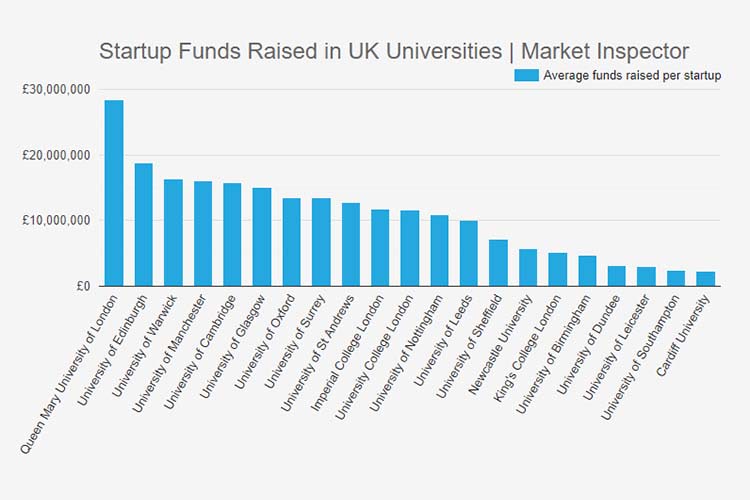In 2019 Top Innovative Universities Will Be Dominated By Women

Every innovation starts with an idea of something new or different: a device, method, or process of discovering new ways of doing things.
Universities are often the places where the greatest ideas are not only born but also shaped to become ready to be implemented in practice.
Innovative universities have an influence on their students, not only during the programmes but also after the graduation by impacting their way of thinking, approaching, and working.
According to a study conducted by Reuters, in 2019 women will constitute the majority of students in 71%of the top innovative UK universities.
The biggest differences in proportions have been registered in:
- King’s College London and University of Dundee – 62% female vs. 38% male students
- University of Edinburgh and University of Leeds – 60% female vs. 40% male students
- University of St Andrews, University of Glasgow and Cardiff University – 58% female vs. 42% male students
To explore the subject and highlight the most innovative British universities, Market Inspector has conducted a study with a comprehensive scoring system, based on two metrics:
- the number of successful patents calculated for 1000 students, and
- the most successful startups established by particular universities’ graduates.
The Winners in Innovation
According to Market Inspector’s findings, the most innovative universities are: Imperial College London, University of Oxford, and Queen Mary University of London.

Imperial College London
Through our analysis we found that Imperial College London is the most innovative university in the UK. It ranked first for patents per 1000 students with a yearly average of 1.23 approved patents.
Also, the university had 221 startups founded by alumni receiving on average £11,837,278 per startup in seed capital. Based on the minimum, maximum normalisation formula, Imperial College London had a score of 68.50%.

University of Oxford
The second most innovative is the University of Oxford with a yearly average of 1.13 granted patents per 1000 students. However, when reviewing startups, the University of Oxford had 348 in total over the 5-year period with an average of £13,500,450 in capital raised per startup.
Based on both metrics, the university scored 67.27%, being only slightly below our number one.

Queen Mary University of London
The third most innovative university is Queen Mary University of London, with a yearly average of 0.33 approved patents per 1000 students, placing the university in the upper midrange of this metric.
However, this university ranked number one for the average amount of funding per startup with 60 startups in total with an average financing of £28,352,835. Queen Mary University of London had an overall score of 61.53%.
Relevant Findings
This section presents separate results for both metrics used in a comprehensive scoring system, as well as an interesting finding on the gender proportions in the majority of top innovative universities in the UK.
Patent Distribution by a University and an Industry
When analysing the patents registered in each of the 21 universities during the period between 2011-2016, we looked not only at the total score, but also at the numbers of patents in the certain categories. It enabled us to determine the industries with the highest level of innovative activities.
The most patents (534) have been registered in pharmaceuticals and biotech, with the second industry being chemicals (249 patents), followed by medical devices and healthcare (199 patents). The fourth industry with the most innovative activities is agriculture, forestry, and food (172 patents).
Average Funds Raised
Through our research we found that Queen Mary University of London ranked first for the highest average funds per startup at £28,352,835. This is in part due to the lower amount of startups from the university and the high amount of seed capital. Queen Mary University of London had 60 startups and a total of £1,701,170,120 of funding between them in total. The University of Edinburgh was positioned on the second place, with £18,856,321 in funding on average for startups.
The University of Edinburgh was in the upper midrange for the number of startups created at 161, and had one of the highest amounts of capital raised at £3,035,867,730, only being surpassed by the universities of Oxford and Cambridge respectively.
The University of Warwick was placed third for average capital raised per startup with £16,401,962. The university had a total of 119 startups funds among its alumni taking a position in the middle of the sample range with a total of £1,951,833,543 being raised across the startups.
| University | Average funds raised per startup |
|---|---|
| Queen Mary University of London | 28,352,835.34 |
| University of Edinburgh | 18,856,321.31 |
| University of Warwick | 16,401,962.55 |
| University of Manchester | 16,131,366.20 |
| University of Cambridge | 15,802,363.85 |
| University of Glasgow | 15,107,520.72 |
| University of Oxford | 13,500,450.89 |
| University of Surrey | 13,437,146.80 |
| University of St Andrews | 12,832,994.92 |
| Imperial College London | 11,837,278.35 |
| University College London | 11,583,538.58 |
| University of Nottingham | 10,877,172.26 |
| University of Leeds | 10,036,636.50 |
| University of Sheffield | 7,176,307.07 |
| Newcastle University | 5,717,971.88 |
| King’s College London | 5,200,479.18 |
| University of Birmingham | 4,720,178.32 |
| University of Dundee | 3,210,297.50 |
| University of Leicester | 2,965,305.77 |
| University of Southampton | 2,508,030.92 |
| Cardiff University | 2,295,455.11 |
Methodology
The research conducted by Market Inspector aimed to identify the most innovative universities in the UK based on the output of the past and current students. When collecting data, post-undergraduate, graduate, full-time, as well as part-time students were taken into consideration. The ‘most innovative’ university ranking is based on the rate of successful patents registered at the educational institutions, as well as the rate of students whose success can be related to the universities they graduated from.
The final results have been achieved by using two metrics to give an overall rating of the top innovative universities in the UK.
Description of Metrics Used in the Project
For the first metric we used the Reuters report ‘Europe’s Most Innovative Universities 2018’. Firstly, we established the number of patents approved at the particular universities over a five year period (2011-2016). Secondly, we looked at the average enrolment across those universities over the same period. Lastly, we determined the average amount of patents approved by each university, divided them by 5 to find the yearly average, and calculated per 1000 students.
For the second metric, we used the database from Angel.co. Firstly, we determined the number of startups established by the graduates of previously listed universities. Secondly, we calculated the total amount of seed funding received by all startups, separately for each university. Finally, dividing the total funds by the number of startups, we anticipated the amount of funding that each startup has received on average.
After gathering data and determining the 21 top innovative UK universities, a minimum maximum normalisation has been used to determine the overall ranking. Both the patents per 1000 students, and funding per startup were weighted equally.












Responses